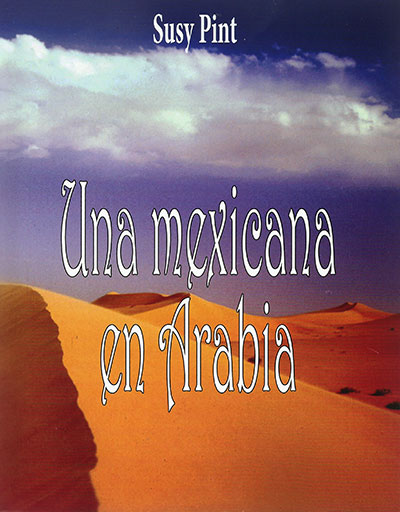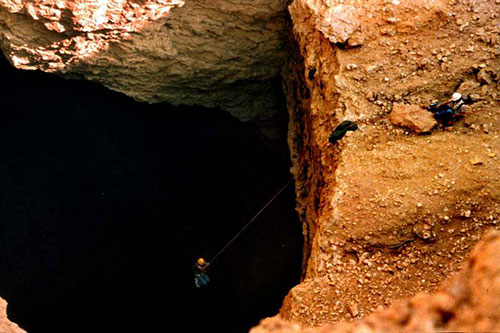|
EN ESPAÑOL
 In
his Presentation to this book, Alfonso Sahagún says: In
his Presentation to this book, Alfonso Sahagún says:
"A Mexican Woman in Arabia...
but not there as a tourist scribbling a few notes between hotels... She
lived there for twelve years!
We know that Saudi Arabia is
the world's biggest oil producer, that it is a desert and its people
are Muslim. The author takes us deeper into each of these subjects as
she crisscrosses the country from the border with Yemen to the edge of
Iraq. With her husband she shares an enthusiasm for the exploration of
caves, those known--but not explored--by the locals as well as caverns
whose very existence had never been suspected. In time, she became an
integral--but always unofficial--part of the Saudi Geological Survey
Cave Unit.
Susy Pint describes her experiences in the desert where she and her
husband camped. Nevertheless, what is most valuable in this book is the
understanding she gained of the Arabs' culture. As for its style, Una
Mexicana en Arabia is descriptive, joyful, picturesque and poetical.
Una Mexicana en Arabia
by Susy Pint
TEXT IN SPANISH
184 pages, 57 photographs in color
Editorial Agata, Guadalajara, Mexico
Price: 14 dollars (250 Mexican pesos)
Available from:
RanchoPint @ Hotmail .com
Telephone (Guadalajara,
México) (52) 33 31 51 16 12
We can ship to any
point in the world
EXCERPT FROM THE BOOK (Translated from the Spanish)
CHAPTER III
DHARB AL-NAJEM
(THE PLACE WHERE THE STAR FELL)
It
was a Wednesday—the last day of the Saudi work week—when we left
Dhahran in the middle of a heavy rain that kept the Land Rover’s
windshield wipers operating at top speed. It was five-thirty in the
evening; our destination: Majma’ah, a city located 280 kilometers
northwest of Riyadh, the capital of the kingdom. Fortunately for us,
through the falling drops we could glimpse, on the far horizon, a
limpid blue sky tinged with rose and orange, indicating that this
phenomenon, so uncommon in this part of the world, would soon leave us
behind.
Inside the Land Rover were the four members of our
little expedition, whose goal was to explore Dharb al-Najem, a deep pit
not far from Majma’ah, to which the local people had attributed various
legends. On top of that, because it had never been explored, some tales
insisted that it had no bottom.
“One day I threw a Pepsi can
full of stones into that pit and I could hear it clattering and
bouncing off the walls for sixteen seconds,” a British geologist had
told John and, ever since, he had been obsessed with the idea of
finding that mysterious abyss.
Curiously, all four members of
our group had different nationalities: Ron Kummerfeldt was from Kenya;
Abdulaziz Al-Agili from Saudi Arabia; John from the USA and I from
Mexico…
 ...A
few kilometers ahead of us we could distinguish a dirt rampart forming
an enormous circle about 60 meters around. That was our destination.
This rampart was a barrier built by the local people to avoid driving
into a huge black gaping maw in the desert. Excited, we immediately got
down to work. Ron parked the Land Rover just beyond the rampart so we
cold attach our ropes to it—the normal method for anchoring a line in
the deserts of Arabia. The main rope measured 110 meters and the backup
50. ...A
few kilometers ahead of us we could distinguish a dirt rampart forming
an enormous circle about 60 meters around. That was our destination.
This rampart was a barrier built by the local people to avoid driving
into a huge black gaping maw in the desert. Excited, we immediately got
down to work. Ron parked the Land Rover just beyond the rampart so we
cold attach our ropes to it—the normal method for anchoring a line in
the deserts of Arabia. The main rope measured 110 meters and the backup
50.
John and Ron prepared their rappelling and ascending gear.
John would go down first and Ron would follow him. It was impossible to
see the end of the rope far below, but the two adventurers imagined it
could not be more than 100 meters to the bottom. As John began his
rappel, several rock doves fluttered out of the black hole in disarray,
surely not happy to witness an invasion of their home, which for
generations had remained inviolate. I now took the camera and through
the telescopic lens I could follow John as he disappeared into the
distance, until he seemed transformed into a tiny spider suspended from
a delicate thread...
(If you don't know Spanish, you will find
an English version of the story of the Dharb al-Najem in Chapter Seven
of John Pint's book Underground in Arabia, available from Amazon.

In search of "singing dunes" in
the Dahna Desert.
|

